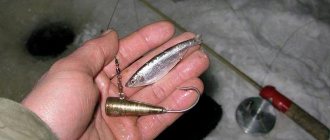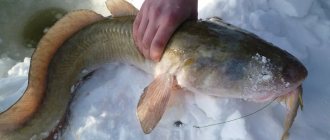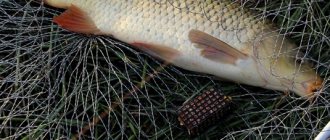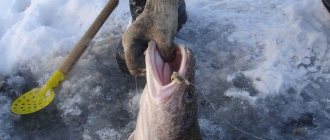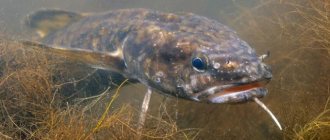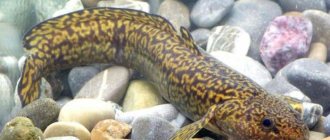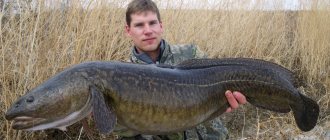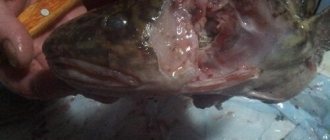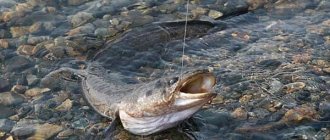07/10/2019 Gregorio Fuentes Hunting and fishing Burbot cannot be called beautiful, rather the opposite. Since ancient times, its extremely unpresentable appearance frightened people, and if the fish was accidentally caught, it was fed to dogs. Then people figured out that under the slippery greenish skin there was delicious dietary meat and healthy liver.
We will tell you what this valuable commercial fish looks like, where and when the largest burbot was caught, and where to go to break the record. And for starters, a couple of fishing tales, where would we be without them?
Ural legends about burbot
Our people don’t like anything slippery, large-mouthed and clumsy, take the same catfish, which was nicknamed the “devil’s horse.” Burbot did not receive a personal nickname, but there are legends about its vitality in the Urals. They say that the filling from whole gutted burbot itself comes out of the pie in a Russian oven, lies next to it 30 centimeters away and is quietly baked there. To be fair, we note that the largest burbot will not fit in the oven, and young fish are excellent for pie.
Another story gives burbots the amazing ability to crawl from the river into the field early on a foggy morning and attach themselves to the udders of grazing cows. And if you have to crawl past a dead animal, the burbot will not miss the opportunity to feast on carrion.
There is some truth in every story. Burbot are indeed extremely voracious, especially in the fall before spawning, and can eat aquatic carrion, and when caught in a common net, they continue to hunt small fish there. Previously, burbots were disdainfully thrown out of nets, but today every fisherman knows this fish and considers it a desirable prey.
general description
Burbot is a predator that, in addition to humans, is forced to beware of natural enemies in nature - catfish and large pike. It is found en masse in northern rivers and deep lakes. In temperate latitudes it lives in limited numbers.
What does burbot look like?
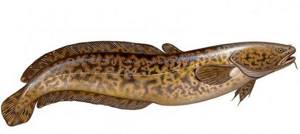
The common burbot is a medium-sized fish. It has an elongated cylindrical body covered with dense, fine-grained scales. The head is flattened, with small eyes and a large mouth. There is one antennae on the chin, pointing downwards.
The color of the body depends on the living conditions of the fish, in particular, the nature of the bottom. Colors can vary from black to light gray. On the sides you can see lighter spots of uncertain shape. Fins are gray. The belly is almost white.
Which family does it belong to?
Burbot belongs to the class of ray-finned fish of the cod family, order Gadidae. This is the only freshwater species that is found en masse in the northern regions of our country. Some ichthyologists consider it monotypic, others distinguish 3 subspecies: common, thin-tailed and North American.
Body structure
The body of the fish has an elongated shape, round in cross section, gradually narrowing towards the tail. River burbot is sometimes more runaway than its lake counterparts. The head of the fish is slightly flattened on top, and its size always exceeds the maximum thickness of the body.
There are two dorsal fins on the top of the body, the last of them is long, like the anal one. The rounded tail fits closely to them. The paired pectoral fins are located on the “throat”, the abdominal fins are lower. The second ones are larger in size than the first ones.
Distribution and favorite habitats
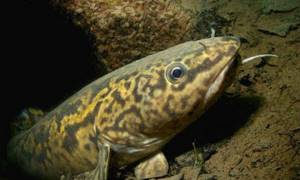
Burbot loves cold areas with clean, clear water saturated with oxygen. Therefore, most of it is found in medium and large rivers, in which there are enough holes, ditches, and deep areas. Prefers a hard bottom with a rocky, pebble, sandy-clay structure.
Habitats of burbot:
- channel holes, dumps, rifts;
- extended ditches, ravines, gutters;
- sharp edges along steep banks;
- areas with medium depths and uneven bottom topography.
Recommended reading: How to catch bream on the river in winter
Burbot also lives in snags. It can be found among single flooded trees and in littered dense supports.
What does burbot look like?
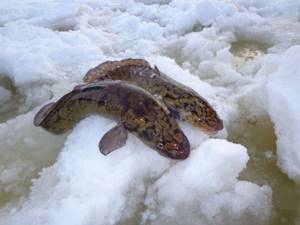
Despite the fact that this fish belongs to the cod family, burbot is not particularly similar to its closest relatives. It can be distinguished by a number of characteristic features:
- highly elongated, slippery body with small scales, rounded in front and compressed from the sides closer to the tail;
- wide, flattened head with a large mouth and small eyes;
- paired mustaches on the upper jaw and one long mustache on the chin;
- brownish, olive or dark gray color of the back, the belly is light, the whole body is covered with a spotted pattern.
Like all cod, burbot is not particularly large in size. The average length of adult fish is about 40 cm and weighs 2 kg. The largest burbot caught, the dimensions of which were officially confirmed, had a length of 120 cm. The weight of the record holder was 29 kg 970 g.
Main characteristics
The level of distribution of fish is closely related to its inability to remain for a long time in stagnant and excessively warm water. The largest number of livestock can be found in the northern part of the hemisphere, for example, in Siberia and the Arctic Ocean basin, as well as in the North-East and North-West of Russia.
And yet the fish also lives in the southern regions, but this is a very small population. In rivers that flow into the Caspian and Black Seas, the average weight of individuals is no more than 0.7 - 1.0 kg.
Even in cold lakes in the North, this fish will still look for the coolest place. She loves underwater springs, and as a last resort she chooses holes, snags and all kinds of stone piles. The composition of the bottom is not particularly important; it can be clay, sand, pebbles, etc. The only exception is a large amount of silt. The predator has poor orientation in muddy water , so it will not climb into such areas.
Appearance and dimensions
To understand what a burbot fish looks like and identify it as accurately as possible, the easiest way is to compare an individual with a catfish. They are very similar and novice anglers often confuse these two species. The main differences are as follows:
- All codfish have only one barbel on their chin. And in the area of the upper jaw, the burbot's whiskers are much smaller than those of the catfish.
- Catfish are large in size. Its head is very impressive and powerful, in contrast to the flattened burbot.
- The catfish does not have chaotically scattered spots throughout the body and its color is darker.
In addition, in addition to differences in appearance, these two predators have different habits. Burbot is most active during the cold period of the year, in contrast to catfish, whose activity is more productive in May-July. Spawning of a representative of cod occurs in winter, and for catfish this happens at the end of May.
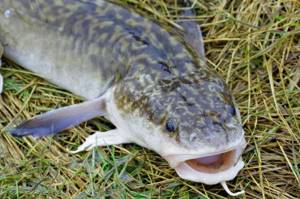
The average weight of burbot reaches 3-6 kg.
The average size of burbot: weight 3−6 kg and length 60−80 cm. The record-breaking fish reached 120 cm in length and weighed 25 kg. The way burbot looks is affected by age, water quality, habitat conditions and bottom type. The most common species are an olive belly, black-gray fins and dark sides. With the onset of old age, the color fades.
Habits and characteristics
The predator is active only at night. Its senses are designed for hunting in the dark. The light of the sun irritates the eyesight of the inhabitant of the depths, so he spends the whole day in his shelter (in a hole or under stones).
The same behavior of fish manifests itself with a significant increase in water temperature, which causes a lack of appetite and apathy. In cloudy and cool weather, it becomes voracious and active.
Another interesting habit of the predator is its observation of sounds. Burbot has excellent hearing and is inquisitive, trying to find sources of noise.
Where are burbot found?
This fish lives in cold rivers of Eurasia and North America, as well as in lakes of northern latitudes.
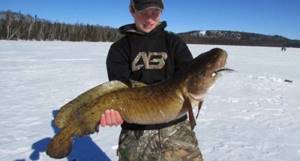
Previously, the burbot's range was extremely extensive, but today they are extremely rare in Germany, Austria and France, and have completely disappeared from the waters of Great Britain, Ireland and Belgium. In Scandinavian countries, burbot is quite common, although its numbers are declining in some places. But Russian fishermen catch burbot in all water bodies of the temperate and Arctic zones, and residents of Siberia can boast of the largest catch.
The largest burbot in the world was caught in the Norilka River basin in the north of the Krasnoyarsk Territory. The owner of the rare trophy was fisherman V. Kopylov, and since 1967 the Siberian’s record has not been repeated.
Winter fishing for burbot
Fans of catching large burbot go to Yakutia. There, on the Lena River, there are specimens weighing up to 16 kg. An ordinary burbot weighs 3-4 kg. Residents of Siberian villages eat this fish in winter. The Yenisei, Irtysh, Pechora, and Ob are famous for their rich catches of burbot. Experienced fishermen advise catching burbot at night.
This fish loves medium depths and shallow rivers. They catch burbot using bait that imitates fry (spinners, jigs). This fish bites well in frosty, windless weather (from -10 to -15 degrees). In the evening, local residents set traps for burbot, and in the morning they take out the catch.
Habitat and size of burbot
The only cod fish that lives in fresh waters is burbot. Representatives of sedentary populations, permanently living in stagnant bodies of water, are the smallest and slowest growing, while large semi-anadromous burbots are found in rivers, for example, in the Lena and Ob. The size of burbot depends on the water temperature: the colder the river, the higher the chances of catching a large fish.
Although the largest weight of burbot is almost 30 kg, old-timers of Siberia claim that fish weighing 34 kg and 180 cm long were caught here. Unfortunately, the veracity of this data has not been confirmed, so when going fishing, do not forget the scales, tape measure and camera.
Features of spawning
The exclusivity of the cold-loving predator directly affects the timing of egg laying. Depending on the region and the specific habitat of burbot, spawning occurs between late December and February. In order for the eggs to develop properly, the water temperature must be +1°C. In northern latitudes, such conditions are created quickly by nature and last for several months. In the temperate zone, this is much more difficult, so the fish have developed the ability for parthenogenesis (“virgin reproduction”) - the full development of an unfertilized clutch. This amazing quality allows females to successfully solve the problem of procreation on rare days of sharp cold weather, without spending extra time searching for sexually mature males.
Burbot spawning occurs in shallow water areas with a slow current and a hard bottom: stone, shells, pebbles, sand. To do this, the fish makes long migrations, often to the places where it was born. The first to arrive at the spawning ground are large individuals, which lay eggs in small groups of 15-20 pieces. Then the medium-sized specimens also begin spawning in small flocks. The last to arrive are sexually mature young animals (3-5 years old), which gather together in noisy “companies” of 50-100 pieces.
Unlike other freshwater fish, cod eggs have good buoyancy due to the oily coating, so part of the clutch drifts freely and is transported by the current to areas of the reservoir with different microclimate conditions, which increases the chances of survival of the genus.
During spawning, the predator actively feeds, so in regions with a limited population there is a partial or complete ban on winter fishing.
To learn more:
Fishing for burbot in winter
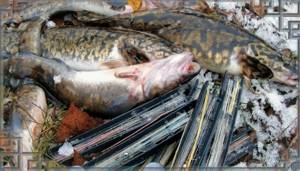
Where to look for burbot
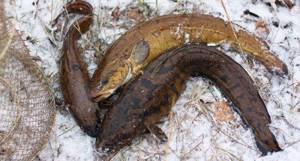
These fish are extremely demanding on the quality of water and soil, so pollution of rivers and lakes has caused the extinction of the species in many areas of its range.
Burbots live best in clean, slow-flowing rivers with a water temperature of 0 to +10 °C. They avoid shallow water; they love depths of 3 m or more, clay or rocky bottoms with various shelters. By the way, the largest burbot fish was caught in ideal conditions. The Norilka River becomes covered with ice already at the end of September, and water transport resumes only in mid-June.
At water temperatures above +14 °C, burbot become lethargic, lose their appetite and hide in bottom shelters, so in the summer it makes no sense to count on a rich catch. Another thing is the off-season and especially winter. The best time to catch burbot is in the fall during the feeding period or from December when these fish spawn.
Experienced fishermen recommend using the following as bait:
- ruff or crucian carp;
- large worms: live or silicone;
- strips of lard;
- frozen shrimp;
- pieces of foam rubber, slightly soaked in fir oil;
- Albumin-based baits.
The best places for burbot to bite are steep river banks and rocky embankments. The optimal time is from sunset to dawn, because burbot does not like daylight. And according to the observations of the famous Russian zoologist L.P. Sabaneev, it doesn’t hurt to light a fire on the shore: for some reason, light in the night really attracts burbots. And of course, the rod must be tough and durable, in case you come across the biggest burbot in the history of fishing! The main thing is to remember to document the trophy before the fish goes to the table.
Gear and equipment
Donka and zakidushka are most often used when catching fish living at depth.
The bottom fishing rod is preferable for active fishermen. The spinning rod must have a test corresponding to the weight of the sinker. The bell serves as a bite alarm.
A feeder is useful for catching sneaky fish. It differs from a standard bottom fishing rod in that it has an elongated rod, and it has more rings, they are located closer to each other. The flexible end perfectly shows the first cautious bite.
The feeder is equipped with a feeding trough. You can use a sinker instead. The test may also have different weights. When fishing with a bottom, there is no time to freeze; the fisherman constantly moves along the shore. The jerk is immediately visible.
Zakidushka is a simplified version of donkey, it is used for passive fishing. The most primitive version of such delivery is a hook on a fishing line, which is tied to a stone or branch on the shore. Since the bait weighs very little, you can bring a sufficient number of them to the fishing spot and place them along the shore every few meters.
A fisherman can sit comfortably, for example, by a fire, waiting for a good catch. Supplies should be checked regularly for the presence of fish.
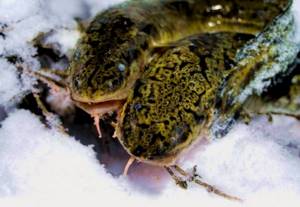
Regardless of the method, the equipment must have characteristics that will help you quickly catch a bucket of fish:
- use of a tungsten leash;
- Possibility of quickly changing the leash.
A tungsten leash, instead of a regular, even the thickest fishing line, is useful for hooks that are left for a long time. Burbot can grind a regular fishing line with its jaws while the fisherman is away.
A quick change of leader is needed if the fish has thoroughly swallowed the bait and is firmly hooked. Therefore, it is better to store spare leashes and mount the equipment on a fastener.
Benefits and calorie content of burbot meat
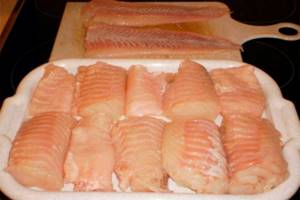
If you have the opportunity to catch burbot for future use, you will provide your family with a valuable dietary product that is useful for children and adults, pregnant women and everyone who cares about their health and figure.
100 g of burbot meat contains only 90 kcal, and there are no carbohydrates at all. The meat also contains a high content of vitamin B1, and useful microelements include iron and 7 amino acids essential for the body. Burbot meat tastes like lobster.
But the liver of this fish is very fatty and filling. Its calorie content is 613 kcal/100g, and among the useful components it is worth noting vitamins D, A, PP, C, E, B9 and a whole complex of minerals that improve cerebral circulation, vision and immunity.
Under favorable conditions, these fish live up to 24 years, and it is likely that somewhere in the depths of Siberian rivers the largest burbot is fattening, which could become your record-breaking trophy.
Source: fb.ru
